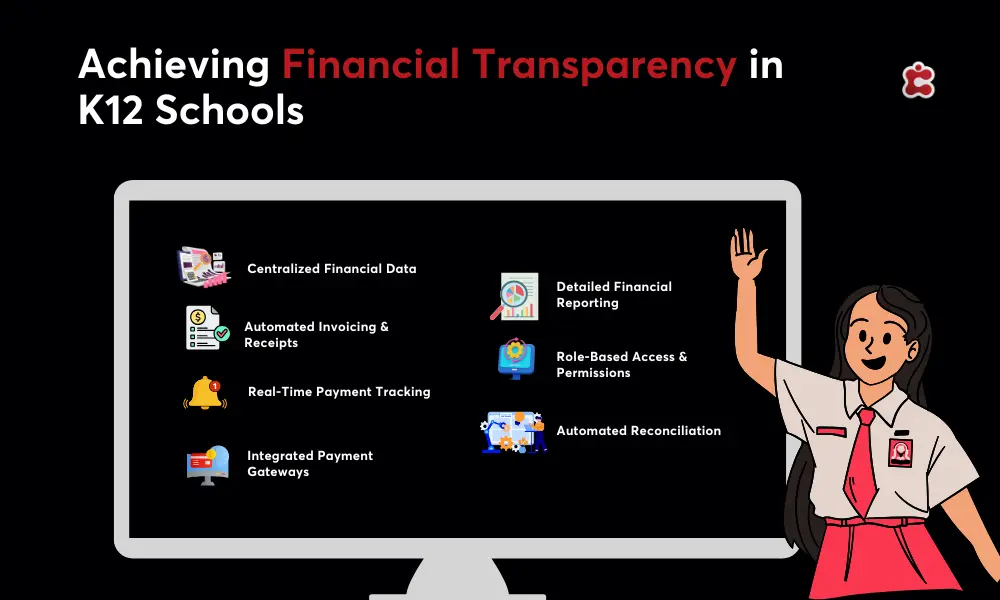Financial transparency in K12 education means giving parents, teachers, and administrators a clear view of how money flows within the school. It’s about ensuring that every fee, payment, and expense is tracked accurately and shared openly.
Today, transparency is more than good practice. It’s essential for building trust, meeting compliance standards, and improving decision-making. Yet many schools still rely on manual records and spreadsheets that cause errors, slow reports, and unclear communication about fees. These outdated methods make it hard to manage budgets or keep parents informed. A School Management System (SMS) changes this. By automating fee collection, recording payments in real time, and generating detailed reports it provides one reliable source of truth. We’ll examine how SMS platforms help K12 schools achieve full financial transparency. It covers common challenges, key features, and the measurable benefits of using technology to manage school finances effectively.

What Financial Transparency Means for K12 Schools
Financial transparency in K12 schools is built on three key pillars that ensure clarity, trust, and efficiency in every financial process. These pillars—accountability, accessibility, and accuracy—work together to create a complete and reliable view of school finances.
Accountability
Financial transparency starts with accountability. Schools must keep clear and traceable records of every transaction, from tuition fees to extracurricular payments. This allows administrators to review spending, identify discrepancies, and stay compliant with financial regulations.
Accessibility
Transparency depends on accessibility. Parents, finance teams, and auditors should be able to access accurate financial data easily. A School Management System (SMS) provides secure, role-based access so each user can view the information they need, anytime and anywhere.
Accuracy
Accuracy strengthens both accountability and accessibility. Real-time data updates and automated reconciliation reduce human error and prevent duplicate entries. With verified, consistent information, schools can make informed decisions and maintain full financial confidence.
How School Management Software Ensures Transparency
A School Management System (SMS) gives K12 schools the tools they need to manage finances clearly and confidently. By centralizing fee management, integrating payment gateways, and providing real-time reporting, schools can eliminate confusion, reduce errors, and strengthen accountability across every transaction.
Centralized Fee Management
An SMS brings all fee-related processes into one unified dashboard.
- Manage tuition, transport, and activity fees in one place.
- Automate invoicing and send instant payment reminders.
- Provide parents with transparent digital receipts and notifications.
This reduces manual work, ensures consistency, and helps schools avoid misplaced or delayed payments.
Integrated Payment Gateways
Secure, built-in payment options make transactions fast and reliable.
- Support multiple payment methods, including cards, bank transfers, and mobile wallets.
- Track transactions instantly for both parents and administrators.
- Reduce late payments and minimise administrative follow-ups.
Real-Time Financial Reporting
Accurate reporting ensures financial clarity at all times.
- Access smart analytics for income, expenses, and outstanding balances.
- Generate easy-to-read financial summaries and exportable reports.
Keep audit-ready records that simplify compliance and decision-making.
Automation in School Finances
Modern School Management Systems use automation to simplify and strengthen financial processes. Tasks like reconciliation, fee tracking, and reporting no longer rely on manual input or spreadsheets. Instead, automation records every transaction in real time, matches payments with invoices, and updates balances instantly. This reduces errors, saves time, and ensures that financial data is always accurate and up to date. Automated reminders help schools collect fees on time, while smart reporting tools generate instant summaries for administrators and auditors. By removing the risk of human error and delays, automation builds a transparent financial environment. Everyone—parents, finance teams, and school leaders—can access the same verified data whenever needed. In this way, automation does more than improve efficiency. It creates true financial transparency by ensuring every number is traceable, consistent, and visible across the entire school system.
Implementation Tips for K12 Administrators
Creating financial transparency starts with strong implementation practices. School leaders can follow these steps to ensure success when adopting a School Management System:
- Set a Clear Fee Policy – Define all fee structures, payment deadlines, and refund rules before automation begins. A clear policy builds trust and consistency.
- Select the Right SMS – Choose a system with modular finance tools that match your school’s specific needs, such as fee tracking, reporting, and payment gateways.
- Train Staff and Inform Parents – Provide training for finance teams and communicate any new processes to parents to ensure smooth adoption.
- Review and Automate Regularly – Monitor financial reports frequently, identify manual tasks, and automate them where possible for accuracy and efficiency.
Classter’s Financial Management Features for K12 Schools
Classter’s Billing & Payments module provides K12 schools with a complete solution for managing fees, payments, and financial reporting in one secure, easy-to-use platform. Designed to simplify complex financial processes, it helps schools achieve full transparency, accuracy, and efficiency.
Key Features
- Invoice Automation – Automatically generate and send invoices to parents or guardians, reducing manual work and ensuring timely billing.
- Payment Integrations – Connect with trusted payment gateways for secure online transactions, including card payments, bank transfers, and local payment systems.
- Reporting Dashboards – Access real-time data on income, outstanding balances, and payment history through user-friendly dashboards.
Client Example: European University Cyprus (EUC)
European University Cyprus, based in Nicosia, is known for combining academic excellence with innovation. The university faced challenges in streamlining admissions and improving financial management. With Classter’s comprehensive financial tools—secure payment portals, customizable billing plans, and real-time transaction tracking—EUC transformed its financial operations. The result was faster processing, fewer errors, and a more transparent experience for both students and staff.
Ready to bring clarity and control to your school’s finances? Discover how Classter’s all-in-one platform simplifies billing, payments, and reporting. Schedule a demo today and experience seamless financial transparency.
FAQ’s
Financial transparency means providing parents, administrators, and stakeholders with a clear, accurate view of all school-related financial activities, including fees, payments, and budgets. It promotes accountability, trust, and better decision-making across the institution.
School management software centralizes financial processes such as invoicing, payments, and reporting. By automating these workflows, it reduces errors, ensures accurate record-keeping, and gives stakeholders real-time access to essential financial data.
Classter’s Billing & Payments module automates invoicing, integrates with multiple payment gateways, and generates real-time reports. This ensures every transaction is traceable and accurate, helping schools maintain accountability and compliance.

